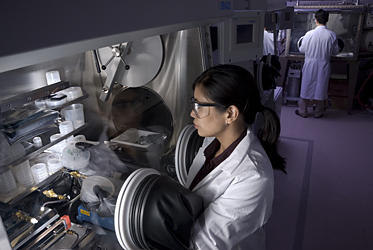Enhancing Science, Technology, Engineering and Math Education
(+$3.4 million)
Challenge

Younger children can learn about science directly from NIST researchers through a 4-H weekend enrichment program and special events throughout the year. Local teachers can update their skills and improve their curriculum through the NIST Summer Institute for Middle School Science Teachers. Older students benefit from NIST's awards for local science fair projects, as well as the 12-week Summer Undergraduate Research Fellowship program, which brings in about 130 students each summer to work side by side with NIST researchers.
NIST's primary contribution to the nation's STEM education, however, is its prestigious postdoctoral associateship program, which is administered in cooperation with the National Academy of Sciences/ National Research Council (NRC). Postdoctoral associates—fresh graduates of university Ph.D. programs—are competitively selected to work at NIST for a two-year appointment. Under the supervision of senior staff, "postdocs" improve their skills and learn to lead independent research, while helping NIST respond more effectively to industry's evolving measurement and technology needs.
Recognizing these benefits, Congress authorized NIST in 2007 to double its previous hiring cap of 60 postdocs per year. However, NIST only has enough funding to hire 30-35 new postdocs per year.
The two-year associateships also provide a cost-effective recruitment tool for NIST, which faces a larger than usual number of vacancies as baby boomers reach retirement age. In recent years, about one-third of the NIST NRC postdocs have accepted positions at NIST following their postdoctoral tenure, accounting for a significant number of NIST technical hires each year. Alumni of the program include a MacArthur "genius" grant fellow, two Presidential Early Career Awards for Scientists and Engineers, and one Nobel laureate, all of whom are still at NIST.
Proposed NIST Program
Funding provided through this initiative will allow NIST to:
- offer an additional 23 postdoctoral positions per year, helping restore the program to 2006 hiring levels and a total FY 2011 total of $14.85 million; and
- support annual salary increases that allow the program to remain competitive with other NRC postdoctoral programs and absorb increasing costs.
Expected Impacts
Hiring the additional postdoctoral associates will help NIST to respond more quickly to industry's measurement and technology needs by ensuring that NIST has enough scientists and engineers who are skilled in the latest university research.

